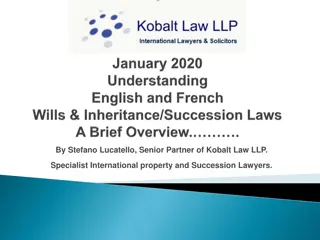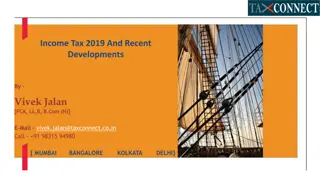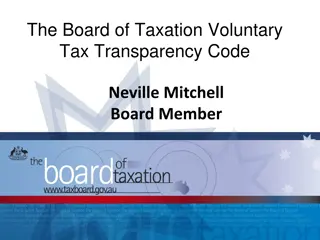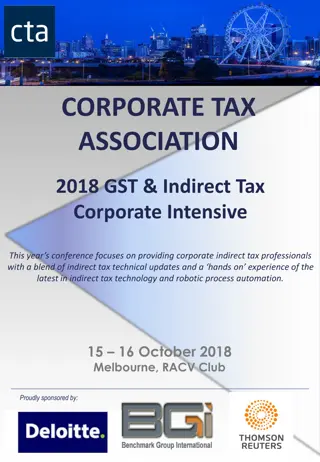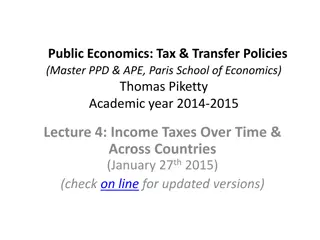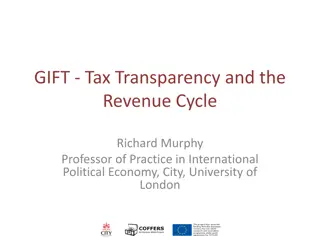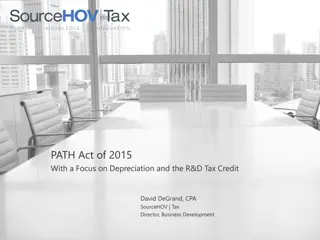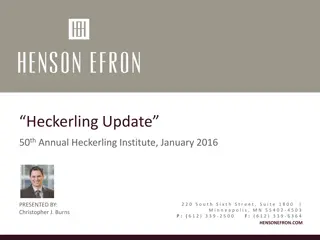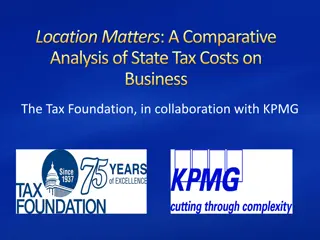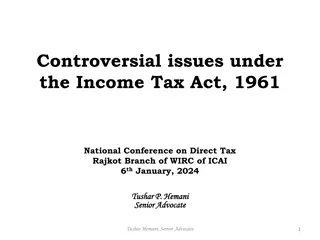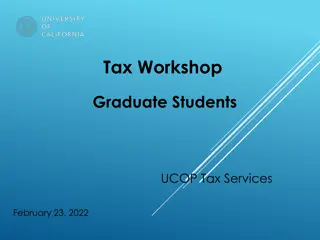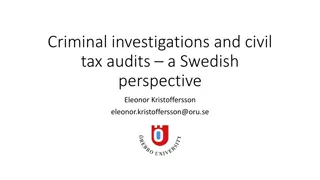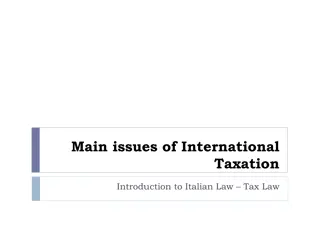International Tax Conference Insights and Developments 2019
Explore key topics discussed at the International Tax Conference 2019, including anti-avoidance strategies, interpretation of tax treaties, GAARs following BEPS, and changes in the tax landscape. Insights on substance over form, GAAR/POEM experiences, and the impact of BEPS on tax treaties are highlighted.
Download Presentation

Please find below an Image/Link to download the presentation.
The content on the website is provided AS IS for your information and personal use only. It may not be sold, licensed, or shared on other websites without obtaining consent from the author.If you encounter any issues during the download, it is possible that the publisher has removed the file from their server.
You are allowed to download the files provided on this website for personal or commercial use, subject to the condition that they are used lawfully. All files are the property of their respective owners.
The content on the website is provided AS IS for your information and personal use only. It may not be sold, licensed, or shared on other websites without obtaining consent from the author.
E N D
Presentation Transcript
Plenary 3 1 INTERNATIONAL TAX CONFERENCE 2019 International Fiscal Association & International Bureau of Fiscal Documentation (IBFD) April 26-27, 2019 The Lalit, New Delhi The new form of substance over form, GAAR/ POEM experiences and perspective
Anti-avoidance in the pre-BEPS world 2 Tax treaties different from other treaties operate along with domestic law treaties allocate right to tax, but domestic law taxation! Should tax treaty benefits be granted in situations involving tax avoidance? Interpretation of tax treaties Arts. 26, 31 of VCLT involved both require interpretation of the treaty in good faith Does good faith include preventing tax avoidance? Arguable yes since a taxpayer as a subject to treaty should have equal rights/obligations; But also no because good faith obligation on parties to treaty i.e. the States, not taxpayer
Anti-avoidance in the pre-BEPS world 3 Pre-2003 OECD position anti-avoidance rules must be in line with tax treaties 2003 OECD Commentary factual approach anti-avoidance rules only determine facts leading up to tax liability no conflict with treaties; also guiding principle later turned into PPT principles later adopted in UN Commentary as well Interpretive value of OECD/UN Commentary questionable especially for a non-OECD member country like India may be supplementary under Art. 32 VCLT, but likely not primary! Courts different positions on issue A Holding (SWI), Yanko Weiss (Israel)
GAARs in treaties following BEPS 4 In terms of general anti-avoidance mechanisms, BEPS AP6 minimum standard is change to preamble + addition of treaty avoidance rule. Treaty avoidance rule options: PPT alone PPT + simplified LOB Detailed LOB + domestic anti-conduit rules Main changes in the anti-avoidance environment following BEPS to be analysed based on this
The preamble change under AP6/MLI 5 Article 6 of the MLI implementing BEPS AP6 adding the following to preamble of treaties: Intending to eliminate double taxation with respect to the taxes covered by this agreement without creating opportunities for non- taxation or reduced taxation through tax evasion or avoidance (including through treaty-shopping arrangements aimed at obtaining reliefs provided in this agreement for the indirect benefit of residents of third jurisdictions), .
The preamble change under AP6/MLI 6 Preamble may be considered showing object and purpose of a tax treaty Art. 31 VCLT requires treaties to be interpreted based on ordinary meaning of terms in their context, in light of its object and purpose Object and purpose of treaty itself relevant here ( its ) so going forward, changed preamble may be considered part of object and purpose of treaties - even internal context - reference in 31(2)! Inherent, interpretive anti-avoidance in treaties following change! Use of domestic GAARs/SAARs also allowed without restriction?
The preamble change under AP6/MLI 7 Jurisprudence on the interpretive relevance of the preamble: Azadi Bachao encouragement of mutual trade and investment from Mauritius treaty considered relevant also in other Indian cases (Abdul Razak Memon AAR; Indian Famers Delhi Tribunal) Bayfine UK (UK) reference to preamble to determine purpose avoidance of double taxation read into prevention of fiscal evasion Alta Energy Luxembourg (Canada, 2018) Luxembourg company sold shares of Canadian sub, claimed 13(5) exemption CRA challenged as avoidance under Canada s GAAR, relied on preamble Court - old preamble indicative of general purpose , vague policy not suitable to interpret specific articles! Old preamble vague indeed; is the new preamble vague and general policy as well?
The PPT how to interpret it 8 Art. 7 MLI - PPT 3 elements (Chand, 2018): Benefit under DTC; Reasonable to conclude, having regard to all relevant facts and circumstances, that obtaining that benefit was one of the principal purposes; Unless benefit in accordance with object and purpose Reasonable conclusion discretion to tax authorities Sole purpose v. principal purpose v. one of the principal purposes extends even to cases with other non-tax reasons weightage? Grandfathering not clear; substance at investment v. time of test? Fulcrum interpretation of purpose and principal purpose
The PPT how to interpret it 9 One perspective Explanatory Statement signed with MLI by all signatories different from OECD Commentaries and other similar instruments MLI is an treaty interpret Art. 7 using Art. 31(1) VCLT ordinary meaning of terms in their context ; Art. 31(2) context includes any instrument signed along with the treaty Explanatory Statement part of context but makes clear that it is only procedural, substantive issues dealt with in BEPS Reports! So, interpretive value to BEPS AP6 report, Commentaries as context indirectly? Examples given by OECD, safety mechanisms may have value in autonomous interpretation of treaty!
The PPT how to interpret it 10 Other perspective purpose undefined term Art. 2(2) MLI undefined terms to have meaning in the treaty unless context otherwise requires; Art. 3(2) treaty says if undefined in treaty, meaning in domestic law unless context otherwise requires Meaning of purpose undefined, no clear direction in context so may go to domestic law (unclear which country law!) Can India use Indian GAAR and meanings, connotations, interpretations of Indian authorities/Courts to define purpose ? Particular issue following Finance Act, 2017 changes to S. 90, ITA
Discussion points 11 India s erstwhile judicial approach to tax avoidance (Mcdowell, Azadi, Vodafone and onwards) impact on interpreting the PPT? Unlikely since PPT broader than narrow sham arising from common law Indian GAAR now more beneficial to taxpayer than PPT? Main purpose v. one of the principal purposes BEPS reports and related Commentaries main way to prevent unfettered use of PPT, but restrict to situations intended to be covered by the OECD How to deal with a situation such as interest deduction avoidance that is covered by a domestic SAAR, domestic GAAR and perhaps even, the PPT and/or other treaty based rules?
Doctrine of Business Purpose and Substance-Over-Form 12 Gregory vs Helverig (1934) - US It does not follow that Congress meant to cover such a transaction. The meaning of a sentence may be more than that of the separate words, as a melody is more than the notes, and no degree of particularity can ever obviate recourse to the setting in which all appear, and which all collectively create. If what was done here was what was intended by [the statute], it is of no consequence that it was all an elaborate scheme to get rid of income tax, as it certainly was [But] the purpose of the section is plain enough; men engaged in enterprises might wish to consolidate, or divide, to add to, or subtract from, their holdings. Such transactions were not to be considered as realizing any profit, because the collective interests still remained in solution. In other words, the benefit of the objective tax result would be denied, where the transaction did not change the economic position, apart from the tax benefit, nor did it reflect any facet of the business, which could be considered as lacking economic substance, and was not the thing which the statute intended .
GAAR around the World 13 Countries Introduction Trigger/ Highlights Burden of Proof Australia 1981 Scheme; dominant purpose to obtain tax benefit Tax payer Shared - Tax payer and tax authorities Canada 1988 Abusive tax avoidance; transaction includes events Arrangements that abuse tax incentives; treaties; corporate structure; use tax havens for avoidance of taxes; etc. China 2008 Tax payer Shared - Tax payer and tax authorities Tax payer Tax authorities Tax authorities Germany 2008 Inadequate arrangement leading to tax benefit Ireland Italy Netherlands 1989 1997 1959 Tax avoidance transaction Lack of business reasons; undue tax reduction Transaction with pre-dominant aim to avoid taxes Impermissible avoidance arrangements; sole / main purpose to obtain a tax benefit Arrangement to alter incidence of tax South Africa 2006 Tax payer Singapore 1988 Tax payer United Kingdom Arrangements are "tax arrangements ; tax arrangements are abusive Tax authorities 2013 A host of other countries including Belgium, Brazil, France, South Korea, Sweden, Switzerland, Turkey have also implemented GAAR provisions
GAAR Controversies/ Issues 14 Interplay with tax treaty Choice of entity in India Inbound intermediary jurisdiction Repatriation Claiming an SEZ tax holiday Choice of funding Debt vs. Equity GST implications buyback vs. dividend vs. capital reduction
Interplay with tax treaty 15 CBDT unclear clarification The CBDT has given an unclear clarification, by stating that the LOB clause in a DTA may not be sufficient to address all tax avoidance strategies and the same are required to be tackled through domestic anti-avoidance rules. If a case of avoidance is sufficiently addressed by the LOB in the DTA, there shall not be an occasion to invoke GAAR. Jurisdiction of an FII If the jurisdiction of an FII is finalised based on non-tax commercial considerations and the main purpose of the arrangement is not to obtain a tax benefit, then GAAR will not apply.
Inbound intermediary jurisdiction 16 What is the issue? Who is tested for GAAR? A foreign company invests in India using a intermediary holding company in a tax efficient jurisdiction Foreign company, Intermediary Holding Company No tax cost on exit What is the tax benefit?
Choice of entity in India 17 What is the issue? Who is tested for GAAR? Can a foreign company choose the entity form in which an investment is made? Foreign company, Lower tax costs on repatriation by choosing an LLP over company What is the tax benefit?
Choice of funding debt vs. equity 18 What is the issue? Who is tested for GAAR? Can tax authorities characterize debt to equity? Indian taxpayer Avoiding dividend distribution tax on equity dividend repatriation. Claiming tax deduction on interest. What is the tax benefit?
Repatriation buyback vs. dividend vs. capital reduction 19 What is the issue? An Indian promoter has invested in an Indian company. The effective tax rate for every rupee of profit repatriated to the promoter can be different under each scenario: buyback, dividend, capital reduction. If the company chooses a buyback over dividend, can the tax authorities impute section 115BBDA tax in the hands of the promoter? Who is being tested? Company distributing the profits? Shareholder approving the transaction? What is the tax benefit Effective tax rate varies in each option
Claiming an SEZ tax holiday 20 3 2 1 What is the issue Does claiming tax holiday result in avoidance of tax for GAAR? Who is being tested Entity claiming tax holiday What is the tax benefit Tax holiday claim
Background to POEM Test : Domestic Scenario 21 Domestic context Income-tax Act, 1961 Section 6(3)(ii) residential status of foreign incorporated companies Definition of POEM under Section 6(3)(ii) OECD Commentary language Change from control and management wholly in India to POEM Justifications for changes from control and management wholly in India to POEM tackle problem created by shell companies / anti-abuse rule+ internationally recognized concept + helps align the provisions of the domestic law with the Indian tax treaties (Explanatory Memorandum, Finance Bill, 2015) how valid are these justifications?
CBDT Guiding Principles on POEM 22 POEM concept is one of substance over form is this really a change in approach? In Radha Rani Holdings v. ADIT (2007) 110 TTJ Delhi 920 POEM pertains to management decisions rather than operational decisions (former refers to decision to open a major manufacturing facility while latter refers to decisions involved in running of facility) New step interposed in analysis: Active Business Outside India (ABOI) When ABOI, there is a rebuttable presumption that the company is non- resident if majority of board meetings were held outside India When no ABOI, two steps: assess person(s) who make the decisions + determination of place of decision making.
How different is POEM from the Control and Management test? 23 Differences: Threshold wholly to mainly / predominantly Turnover / gross receipts less than INR 500 million POEM is inapplicable New test of ABOI could potentially exclude some companies from substantive analysis (in light of the rebuttable presumption) anti-abuse rule using treaty language of passive income Tax rate applicable - 40% (plus cess and surcharge) Does this constitute reasonable classification? (SC in PAN Aadhar case tackling tax avoidance as a justification) Similarities: Enquiry is about top level management decisions and not day to day decision making Substance over form approach guidelines do not have a hierarchy leading to greater uncertainty for the taxpayer Facts would determine the end result subjective analysis
POEM as a Tie-Breaker Rule: Before and after MLI 24 Article 4(3) of OECD and UN Model Convention contemplated POEM as a tie-breaker rule later OECD suggested change to case- by-case approach because dual residence often involves tax avoidance Importance of determining residence jurisdiction to apply distributive rules Article 4, MLI shifts to case-by-case approach resolution through MAP failure of resolution denies relief or exemption except as agreed Not a minimum standard under the MLI - Singapore s reservation POEM is still one of the factors to be considered apart from incorporation, place of board meetings, where senior executives carry out their activities, place of senior day-to-day management, place where accounting records are kept, etc.
Does domestic law play a role in interpreting POEM in tax treaties? 25 Art.3(2) provides that countries may adopt the meaning of a term in their domestic laws to interpret a treaty term unless the context otherwise requires Is the context different? Domestic tax law rule vs. tie-breaker rule (for the purposes of this Convention, the term resident..means) India: Section 90, Explanation 4 : undefined term shall have the same meaning as assigned under the Income-tax Act,1961 and explanation given by the Central Government dynamic or static interpretation? South Africa: Guidance on POEM from the SARS specifies that the notified principles would also be used to understand the tie-breaker rule in its own tax treaties Introduction of POEM in domestic law is perhaps hinged on aligning the tie-breaker rule with the domestic law meaning, rather than vice versa! Reference to domestic law will only come in when all possible interpretation methods do not lead to a satisfying solution (Lang, Introduction to Double Tax Conventions)
26 CASE STUDIES
Case Study: India Mauritius 27 India and Mauritius have both signed the MLI but Mauritius has not listed India as a covered tax jurisdiction Article 4(3) of the DTAA uses POEM as a tie-breaker rule - no change to treaty Looking at the domestic law, India and Mauritius both use POEM in their respective laws The Mauritian Revenue Authority has issued guidance on POEM. A company would have its POEM in Mauritius if (a) the strategic decisions relating to the company s core income generating activities are taken in, or from, Mauritius; and (b) any one of the following conditions is met: (i) majority of the Board of directors meetings are held in Mauritius; or (ii) executive management of the company is regularly exercised in Mauritius SP 17/18 What is the possibility of dual residency claims? Will the Mauritian authorities also adopt a substance over form approach?
Case Study: India Singapore 28 The MLI will not affect the India-Singapore treaty as despite the treaty being a CTA, Singapore has expressed a reservation in respect of Article 4 of the MLI. POEM is the tie-breaker under the treaty. Singapore tax law uses control and management to determine residential status of companies - making of decisions on matters such as company strategy and policy. Location of board of director meetings during which strategic decisions are made is a key factor in such determination. The use of a management based criterion in domestic laws of both India and Singapore and also in the tie-breaker may prove to be complicated if a conflict arises. Would it be appropriate for India to invoke its own domestic law meaning of POEM?
Case Study: India - Netherlands 29 India and Netherlands have both opted for the MLI to apply to their bilateral tax treaty. Hence, residency conflict resolution would be on a case-by-case basis. Dutch domestic law determines residence on incorporation or according to circumstances (place where strategic managerial decisions are made, place of board meetings, residence of board members and location of primary office). Secondary factors such as location of shareholder meetings, place where accounts are kept, main location of business, etc. are also considered. Reliance on myriad factors could result in difference of opinion in understanding POEM in the treaty context. MAP should look at factors other than management?
Case Study: India South Africa 30 India and South Africa have signed the MLI - no reservations case-by-case approach which includes POEM Treaty already says that POEM will be tie-breaker rule and if the question of residential status cannot be resolved, competent authorities shall settle through mutual agreement. Domestic law of both countries use POEM but the understanding in South Africa has changed from day to day management to strategic management after issuance of SARS Interpretation Note 6 The guidance from the revenue authority specifies that the notified principles would also be used to understand the tie-breaker rule in its own tax treaties - similar to Section 90(4) The general principle governing POEM in South Africa is the same as the definition under Section 6(3) of the Indian Act. However, the South African guidance does not have a test such as ABOI and considers economic nexus usually irrelevant. Can there be a dual residency claim? Would it be advisable to use the POEM factor in the MAP process?
Case Study: India USA 31 India has signed the MLI but United States of America has not No change in treaty language Art 4(3) does not contemplate a tie-breaker rule. It does not allow dual residents the benefit of most provisions in the tax treaty. If a company is resident in both India and USA, it will be outside the scope of the tax treaty except for few mentioned articles. Given the subjectivity in the Indian understanding of POEM, it is perceived that foreign companies including those incorporated in United States of America may be considered as Indian residents (for POEM test) if aspects of management such as key strategic decisions made in India by the board (through physical or virtual meetings), delegation of top level management decisions to managers / officers in India and head office being in India. MAP shallendeavor no guarantee that the conflict will be resolved taxpayer has to rely on unilateral relief in such case
32 THANK YOU!
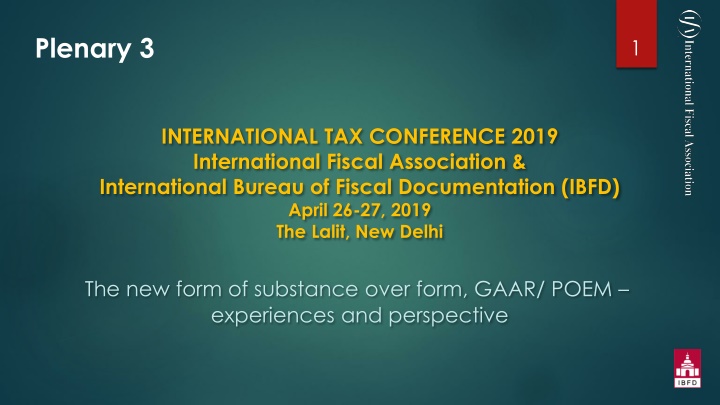


![Town of [Town Name] Real Estate Tax Rates and FY 2024 Budget Summary](/thumb/62211/town-of-town-name-real-estate-tax-rates-and-fy-2024-budget-summary.jpg)


